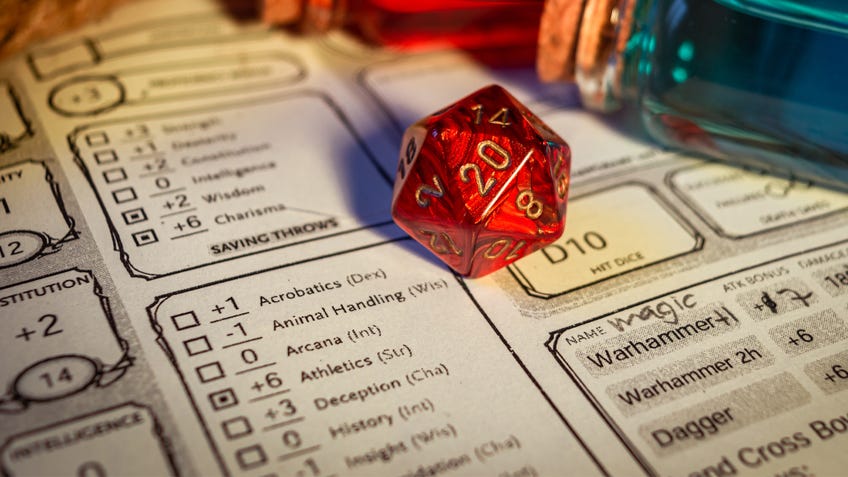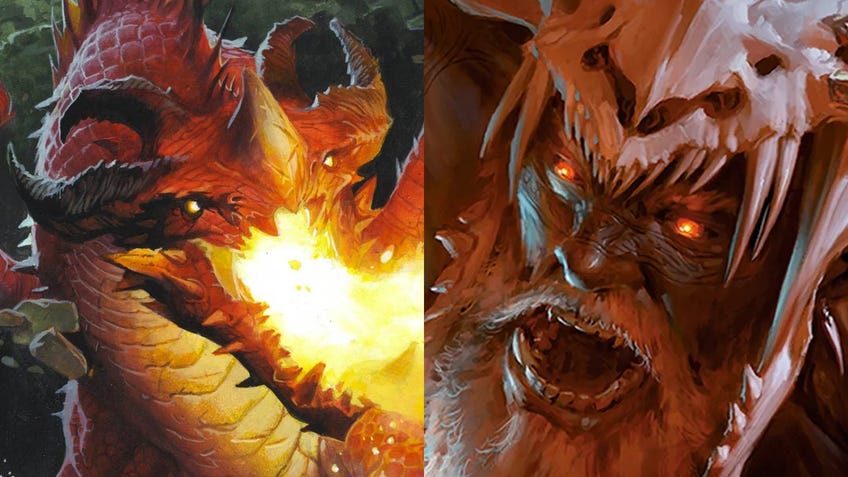D&D 5E vs Pathfinder 2E: Which RPG should you play?
Can there be a winner in the D&D vs Pathfinder debate, or is it more a matter of preference?
When it comes to deciding between D&D 5E or Pathfinder 2E you'll find that, as much as people feel the need to pit them against one another, they have far more in common than they have differences. Both are robust and prevalent tabletop RPG systems with extensive, passionate followings, and both offer heaps of potential for bringing vibrant co-op roleplay stories to life. Rather than it being a case of "Is D&D better than Pathfinder?", the real question you have to ask yourself is what you're looking for as a player or a game master.
Do you want deep and complex character creation with more options than you can shake a staff at? Is it number-crunching and intricate tactics that get you going? Do you prefer to wing it with house rules, or have every possible situation detailed in the sourcebook? How new are you to tabletop roleplaying? All this will factor into your decision, but the main thing to remember is that preference is paramount, and being clued into the strengths of each system is key.
Here we're going to look a little deeper into each of these top-tier tabletop roleplaying games, so you can figure out which will better suit you and your players. That way, you can be more prepared for what each has to offer not only at the start of a campaign, but also as you step through the levels. Hopefully then there'll be fewer surprises for you mid-boss battle.
Creating characters
The first step before any campaign begins is character creation. Session Zero is just as important for both D&D and Pathfinder campaigns alike and, as a GM, the style of characters your players pick should feed into and inform any adventures you're looking to plan.
In D&D 5E, you'll have a good idea of the kind of character your players are going to build from the get-go, as most of their important character creation options come early on in the levelling process. At third level, most of the important character pathing choices are solidified, so you can plan pretty far ahead - unless they're planning to cross class. That is not to say there isn't an incredible breadth of options in D&D they're just more definitive in the kind of playstyles.
At the other end of the spectrum, Pathfinder 2E's character options are not only more, but also more versatile. From ancestry to race, class and subclass options, and the many, many feats, there's so much choice it can all feel a little overwhelming for players, especially if they're new to tabletop RPGs. If customisability is high on your priority list, Pathfinder can give players a chance to make truly unique-feeling characters. At each level, there are important game-changing choices for players to make - but for GMs trying to keep up with the whole party's skill set, it can be a bit overwhelming.
Play D&D if... you have a play style in mind and plan on (mostly) sticking to it.
Play Pathfinder if... you want to mix-and-match with heaps of character choices.

Running a game
Although keeping up with your player's ever-evolving character builds can be difficult, Pathfinder 2E is generally considered a lighter load for GMs compared to D&D 5E, partially for the same reason. While D&D 5E can be easier for new players and GMs to pick up and learn, the higher player workload in Pathfinder 2E can mean less pressure on the GM. It's a system that's suited to more competent players who are willing to take responsibility over their character builds.
The comparatively rules-lighter system of D&D 5E is a big draw for would-be DMs as well as players, but it means that there are a lot of situations that many parties might encounter that aren't covered in the core rules. Players might find themselves in a sticky situation in D&D, only to discover there's no rule to say what you should roll to address it. So you fudge some numbers and hope that it doesn't throw the game out of balance. But having to create and keep track of your own in-house rules can be a slog for some, and later down the line can cause inconsistencies that players might deem unfair.
Pathfinder 2E sourcebooks, on the other hand, cover a much broader range of situations. So while Pathfinder might be more intensive when it comes to rules, and a session can involve stopping to check the book more often, D&D 5E is the less comprehensive of the two. A lack of rules can leave certain people feeling lost, particularly if you're not used to coming up with cohesive rules on the fly.
When it comes to balancing and scaling, Pathfinder 2E’s maths is also considered much tighter than D&D 5E. As such, a lot of GMs feel it's easier to create your own Pathfinder encounters without the numbers coming out whack. It's also important to consider that the rules used by D&D maker Wizards of the Coast for designing monsters are not the same that have been laid down for creating your own encounters. (These are best kept secrets that Wizards of the Coast couldn't possibly share with its audience.) Paizo, on the other hand, doesn't mind you knowing how the Pathfinder 2E backend works.
Calculations that don't quite scale right means tweaking adventures and designing encounters for higher-level characters can be really challenging for a dungeon master, and it's one of the main reasons people prefer Pathfinder 2E for longer-form campaigns.
Play D&D if... you're a new player or GM looking to get into TRPGs.
Play Pathfinder if... you're planning to design higher level encounters.

Combat and dice rolls
Pathfinder 2E has you adding your level to everything you roll, meaning the mathematical progression can be a little intense as a campaign goes on. That's something D&D 5E combats with Bounded Accuracy - a principle that limits the character level-centric numeric bonuses to d20 rolls". For example, the proficiency bonus you add to your rolls can't go higher than a +6, and most ability scores are capped at 20 for players (30 for monsters and divine beings). Attack bonus-granting feats are all but done away with, too. It's a design tactic that very intentionally reduces the complex crunchiness of previous editions, and makes advantage rolls much more relevant. D&D 5E combat feels snappier than Pathfinder 2E in that respect, since there's less calculation needed on the fly.
Both Pathfinder and D&D’s attacks, ability checks and saving throws are built around the four degrees of success: a critical fail, fail, success or critical success. In D&D, a natural 1 always means a crit fail, and a natural 20 always means a critical success. Pathfinder's a little different in that a critical success/failure happens when you roll ten or above/below the designated difficulty rating. To complicate things further, rather than Pathfinder's natural 1 or 20 automatically dictating whether your roll is critical, it instead bumps your level of success up/down by one level. So even if you don't manage to hit ten or more than the DC for that challenge, you can still bump your success up a notch on a natural 20. It means all those modifiers exponentially increase your chances of landing a critical success or failure in Pathfinder 2E.
Although players and GMs alike will tell you that Pathfinder 2E is the much crunchier of the two systems, its granular approach to designing, balancing and resolving encounters means there's so much more tactical depth to be had.
As just one example, when it comes to conditions, D&D 5E will see a hit simply decreasing your health in some manner, but in Pathfinder 2E a hit could cause damage specifically to your Strength stat, for example. There's a little more to think about in Pathfinder combat, especially when it comes to healing and dying mechanics, since Pathfinder 2E's medical system is much more robust and actually useful compared to that of D&D 5E.
That said, there's an uncharacteristic simplicity to Pathfinder 2E's in-combat actions: pick three things you want to do, and do them in any order. Easy. And whereas D&D's extra restrictions can be useful for keeping players in line, explaining all the ins-and-outs of how bonus actions work to a new D&D player can be frustrating.
Play D&D if... you want to avoid too much number crunching.
Play Pathfinder if... you don't mind grappling with a few extra complexities.

So, what should I play: D&D or Pathfinder?
If snappier and less crunchy combat is something you're seeking from your fantasy RPG, D&D 5E’s system gives you much less to think about, bar small things like the bonus/standard action system. It's a much more approachable ruleset, though it relies more on the dungeon master's discretion when it comes to resolving unfamiliar situations.
While D&D 5E is easier to pick up and play, Pathfinder 2E is much more front-loaded but easier to run longer campaigns with, since higher-level play tends to feel more balanced and feasible with better scaling options.
Aside from your willingness to learn complex rules versus your ability to improvise, a lot of the choice here comes down to freedom. If you want freedom to tailor your characters more intricately as they evolve, use your actions in any order during combat, and to design and balance your own encounters, Pathfinder 2E is going to serve you well. Alternatively, if you want the freedom to jump in as a new player, to avoid heaps of mental maths, or improvise rules on the fly as a DM, D&D 5E is your best bet.

